AUSTRIA
Economy

Economy

Cities in AUSTRIA
| Vienna |
Economy
General
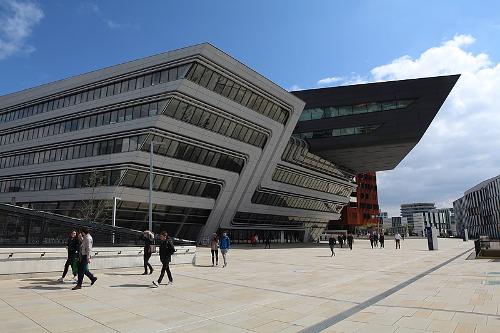 Faculty of Economics in Vienna, AustriaPhoto: Franciszek Vetulani CC 4.0 International no changes made
Faculty of Economics in Vienna, AustriaPhoto: Franciszek Vetulani CC 4.0 International no changes made
Looking at the gross national product (GNP), the level of unemployment and the distribution of the labor force, Austria is one of the most prosperous countries in Europe. Since the 1960s, the Austrian economy has been characterized by a high growth rate and low unemployment. The state played an important part in economic life. Since late 1987, the government has been privatizing part of the state-owned companies. By selling shares, the aim is to eventually place at most 49% of the shares in these companies in private ownership. Consultation between the social partners has created a stable social and economic climate. Economic growth was 3% in 2017. The GDP per capita was $50,000 in 2017. The share of the various sectors in GNP in 2017 was: primary sector (agriculture and forestry) 1.3%, secondary sector (industry, mining, energy) 28.4 and tertiary sector (trade, traffic, government and service sector ) 70.3%.
Recently, government policy has focused on deeper privatization and reform, which has resulted in, among other things, greater labor market flexibility, far-reaching pension reforms launched and new technologies being adopted - a substantial addition to increased export activities.
Agriculture, livestock, forestry and fishing
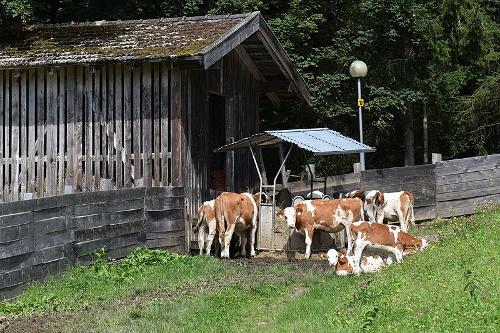 Cows for milk production in AustriaPhoto: Thomas Quine CC 2.0 Generic no changes made
Cows for milk production in AustriaPhoto: Thomas Quine CC 2.0 Generic no changes made
About 20% of the total area is arable land, 28% pasture land and 38% forest (Austria is one of the most forested countries in Europe). The main agricultural areas are in the north and northeast of the country, the somewhat lower and flatter areas. The agricultural yield provides for about 90% of its own needs. In recent years, the number of people working in agriculture and forestry has fallen sharply. The number of companies also fell sharply. Many traditional small farms can only survive because of the additional income from tourism.
In addition to the cultivation of potatoes, corn, grains and sugar beets, fruit and wine grape cultivation is important. The sunny, warm slopes of the low mountain range are very suitable for wine growing. The high mountains are characterized by livestock and agriculture. Livestock farming is mainly carried out on difficult-to-reach alpine pastures (pastures), for the benefit of the dairy industry. In the summer the cattle stay on the alpine pastures and in the autumn they are brought to the villages, a very extensive form of livestock farming.
Forestry provides wood for fuel and the wood processing industry. Three million hectares of the Austrian surface is intended for forestry. About 12,000 m3 of wood is produced per year.
Industry and mining
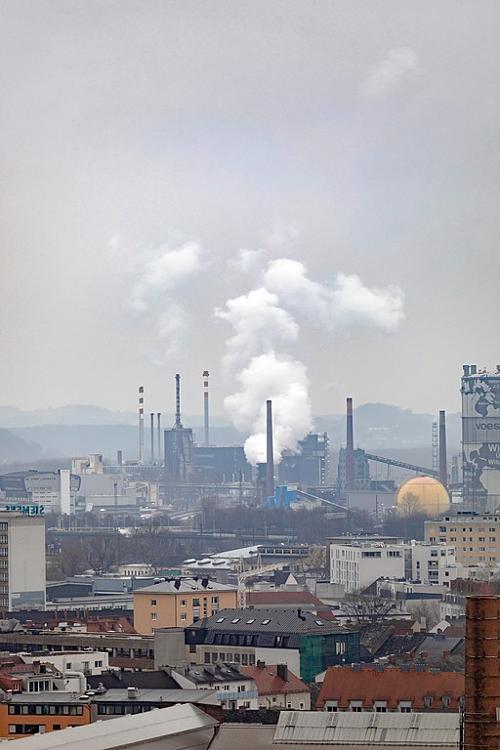 Industrial area near Linz in AustriaPhoto: Manfred Wemer(WMAT)CC 4.0 no changes made
Industrial area near Linz in AustriaPhoto: Manfred Wemer(WMAT)CC 4.0 no changes made
After World War II, the basic industries destroyed during that war were taken over by the government. Investments in new manufacturing methods resulted in a rapidly expanding industry. Important industries are the iron and steel industry, which are concentrated at Linz and Donawitz-Eisenerz. The competitive position has been affected in recent years by cheaper producing countries. Other important industries are iron and metal processing industry, paper industry, electrical industry, textile industry, chemical industry, glass and ceramic industry, food and stimulants industry, machine industry, leather processing and wood processing industry. Industry accounts for more than a third of GDP and a third of employment.
The Alps in Austria are rich in minerals, especially iron ore. Carinthia, Styria and Tyrol provide magnesite, sulfur, zinc and graphite. Copper ore is extracted at Salzburg, and bauxite to the east. In Carinthia lead, rock salt and gypsum, in the south and southeast lignite. Petroleum and natural gas are mined at Zistersdorf, but stocks are modest. Mining has been largely nationalized since 1946 and has always occupied an important place in the economy as an industry, but its significance continues to diminish.
Energy supply
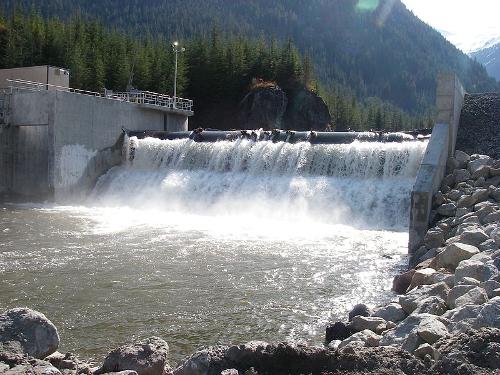 Hydroelectric power plant AustriaPhoto: Alterrapower CC 3.0 no changes made
Hydroelectric power plant AustriaPhoto: Alterrapower CC 3.0 no changes made
The energy supply is based on coal, petroleum, natural gas and hydropower. Most of the 1000 power plants are hydroelectric and provide cheap and clean electricity. Glockner-Kaprun power stations are famous. Nevertheless, a large part of the total energy requirement still has to be imported, mostly from the former Soviet Union.
Trade
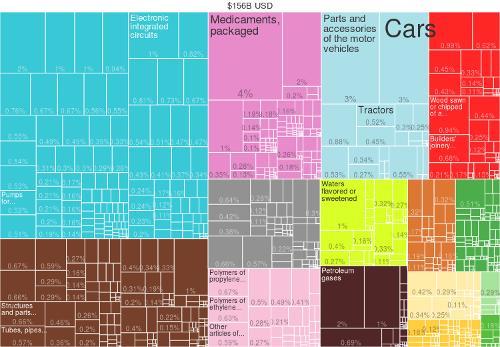 Export AustriaPhoto: Celinaqi CC 4.0 International no changes made
Export AustriaPhoto: Celinaqi CC 4.0 International no changes made
The share of trade has remained fairly constant over the last twenty years. Major exports are iron and steel, clothing, textile products, machinery, electrical energy, timber, livestock and paper; mainly machines and tools, vehicles, foodstuffs, mineral fuels, semi-finished products and raw materials are imported.
Although Austria has close relations with the EC countries, the country is a member of the European Free Trade Association (EFTA), due to the politically neutral nature of this organization. The main trading partners are Germany, Italy, Japan, Switzerland, France, England, the United States and the Netherlands. Transit traffic through Austria is of great importance to the country and plays an indispensable role in the ever-growing trade between Eastern and Western Europe.
Traffic
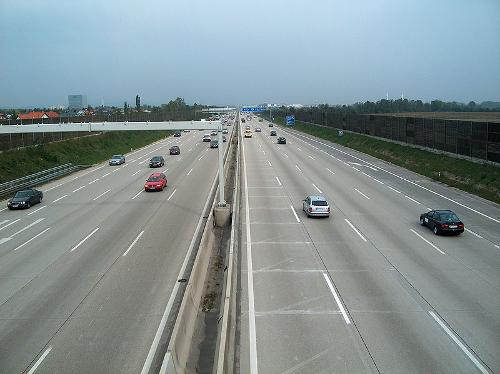 Autobahn in AustriaPhoto: Newsflash CC 2.0 Austria no changes made
Autobahn in AustriaPhoto: Newsflash CC 2.0 Austria no changes made
Austria has an excellent rail and road network as well as one of the most important waterways in Europe, the Danube. Inland navigation on the Danube has increased significantly after the creation of the Rhine-Main-Danube Canal in the 1980s. The Austrian railways (5745 km Bundesbahn) are state-owned. Due to the slowing down of road freight transport, rail transport will become increasingly important. The total length of the road network is over 9,950 km, of which nearly 1,600 km are Autobahn. The main airport is the one near Vienna (Schwechat); there are smaller international airports at Linz, Salzburg, Graz, Klagenfurt and Innsbruck. The national airline company is Austrian Airlines. The Adria-Vienna pipeline supplies crude oil. Large natural gas pipelines also run through the country, from Eastern Europe to Italy and to Western Europe.
Sources
Bendien, M. / Midden-Oostenrijk
ANWB media
Europese Unie
Europees Platform voor het Nederlandse Onderwijs
O'Bryan, L. / Oostenrijk
Gottmer
CIA - World Factbook
BBC - Country Profiles
Last updated June 2025Copyright: Team The World of Info